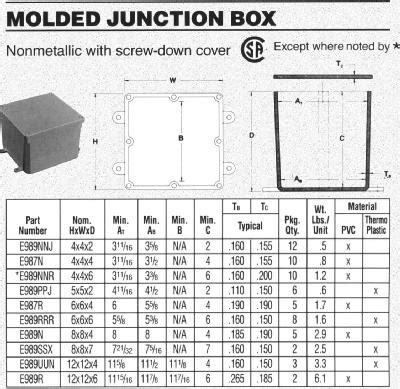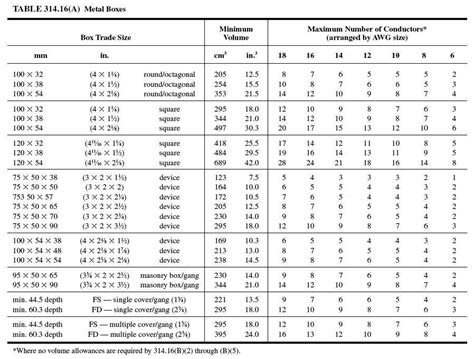common junction box sizes When the box is attached to the drywall, not the studs: Exposed locations or stud . The diverse styles, shapes, thicknesses, and metals of brackets necessitate various manufacturing methods, including casting, stamping, CNC . See more
0 · pvc junction box size chart
1 · nec junction box size chart
2 · junction box standard sizes
3 · junction box size in mm
4 · junction box size calculator
5 · junction box dimensions standard
6 · junction box dimension
7 · different types of junction boxes
Have you ever wondered how different laser cutting machines meet the diverse needs of industries today? This article breaks down the various types of laser cutting machines, from those designed for intricate PCB work to those capable of slicing through thick metal pipes.
A junction box is not a special type of box but any standard electrical box used to enclose wire splices. The most commonly used box for junctions is a 4-inch square box (either metal or strong plastic), which offers ample space for making wire connections with multiple .When nailing the box, use light, careful blows rather than heavy swings of the .When the box is attached to the drywall, not the studs: Exposed locations or stud .Once the hole is cut in the wall for the box, feed the cable (or cables) out through .
Correct fill capacity: The junction box should be large enough to contain the wires. .To install this type of clamp, insert the threaded end into a knockout hole in the . Box Size. Wires, receptacles and switches need adequate space. Crowded boxes can damage wires, resulting in a fire or shock hazard. You can use the chart below to . Use this junction box sizing calculator to determine the recommended dimensions of a junction box depending on the number of straight and angle pulls entering it and meet the National Electrical Code®.
A junction box is not a special type of box but any standard electrical box used to enclose wire splices. The most commonly used box for junctions is a 4-inch square box (either metal or strong plastic), which offers ample space for making wire connections with multiple wires or . Wondering how to size a junction box? Find out how to use the NEC code to determine the size of the junction box that your application requires. Junction boxes are must-have units at home as they protect against electrical issues. Here are a few of the most common junction boxes and where to use them.
Box Size. Wires, receptacles and switches need adequate space. Crowded boxes can damage wires, resulting in a fire or shock hazard. You can use the chart below to calculate the required box size. Add up the numbers for the correspond- ing components in the box to find how many cubic inches you’ll need. Use this junction box sizing calculator to determine the recommended dimensions of a junction box depending on the number of straight and angle pulls entering it and meet the National Electrical Code®.There is a huge selection of electrical boxes, varying by size, shape, mounting device, and composition. One of the first distinctions to note is that of new work boxes and remodel or cut-in boxes.
The sizing requirements for pull boxes, junction boxes, handhole enclosures, and conduit bodies exist to prevent conductor insulation damage. Those requirements are in 314.28, and they apply to all conductors 4 AWG and larger ( Fig. 1 ).Box Selection: Choose a junction box with a minimum volume of 22.5 cubic inches. A standard 4x4x2-1/8 inch box typically provides 21 cubic inches, which would be insufficient. Therefore, a larger box, such as a 4x4x2-1/2 inch box with 24 cubic inches, would be appropriate. Compliance: Always ensure that the chosen box meets NEC requirements. Most electricians know by experience what size box to choose for each application, but with larger devices with lots of wiring or in borderline cases, it may be necessary to perform box-fill calculations. These are covered in National Electrical Code (NEC) sections 314.16 (A) and 314.16 (B). The most common junction boxes are 4 or 6 terminal junction boxes. That said, the exact number of terminals will always depend on how many connections you need to make. When choosing an electrical junction box make sure that you have enough terminals for each pair of wires you wish to connect.

pvc junction box size chart
A junction box is not a special type of box but any standard electrical box used to enclose wire splices. The most commonly used box for junctions is a 4-inch square box (either metal or strong plastic), which offers ample space for making wire connections with multiple wires or . Wondering how to size a junction box? Find out how to use the NEC code to determine the size of the junction box that your application requires. Junction boxes are must-have units at home as they protect against electrical issues. Here are a few of the most common junction boxes and where to use them. Box Size. Wires, receptacles and switches need adequate space. Crowded boxes can damage wires, resulting in a fire or shock hazard. You can use the chart below to calculate the required box size. Add up the numbers for the correspond- ing components in the box to find how many cubic inches you’ll need.
Use this junction box sizing calculator to determine the recommended dimensions of a junction box depending on the number of straight and angle pulls entering it and meet the National Electrical Code®.
There is a huge selection of electrical boxes, varying by size, shape, mounting device, and composition. One of the first distinctions to note is that of new work boxes and remodel or cut-in boxes.
The sizing requirements for pull boxes, junction boxes, handhole enclosures, and conduit bodies exist to prevent conductor insulation damage. Those requirements are in 314.28, and they apply to all conductors 4 AWG and larger ( Fig. 1 ).Box Selection: Choose a junction box with a minimum volume of 22.5 cubic inches. A standard 4x4x2-1/8 inch box typically provides 21 cubic inches, which would be insufficient. Therefore, a larger box, such as a 4x4x2-1/2 inch box with 24 cubic inches, would be appropriate. Compliance: Always ensure that the chosen box meets NEC requirements.
Most electricians know by experience what size box to choose for each application, but with larger devices with lots of wiring or in borderline cases, it may be necessary to perform box-fill calculations. These are covered in National Electrical Code (NEC) sections 314.16 (A) and 314.16 (B).


stainless steel powder coated cabinets

nec junction box size chart
This book covers all three forms of layout as well as geometric construction. It introduces the learner to the techniques used in parallel line, radial line, and triangulation. With videos and animations, the learner has an opportunity to play, pause, and rewind as they practice these techniques.Learn about the many common types of wall and ceiling electrical boxes for switches, outlets, light fixtures, ceiling fans, and junction boxes.
common junction box sizes|different types of junction boxes